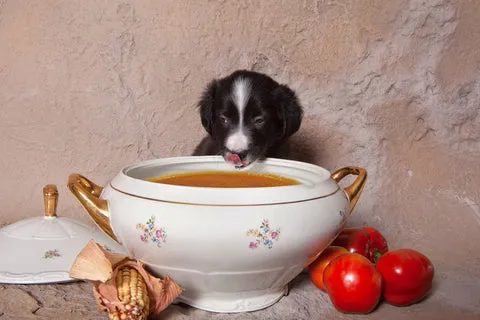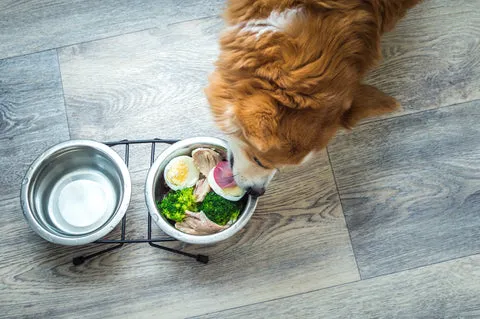When your furry friend isn’t feeling well, it’s natural to worry about what to feed them. Just like humans, dogs often lose their appetite when they’re sick. Knowing What To Give A Sick Dog To Eat can make a big difference in their recovery. This guide provides nutritious and easily digestible options to help your dog get back on their paws. It’s always best practice to consult with your veterinarian for personalized advice.
What to Feed a Sick Dog
A bland, easily digestible diet is generally the best approach when your dog is sick. Here are ten of the best options to soothe your dog’s upset stomach and provide them with the nutrients they need:
1. Boiled White Meat
 A small dog looks attentively.
A small dog looks attentively.
Plain, boiled white meat like chicken or turkey is gentle on a sick dog’s stomach. It’s easy to digest and low in fat, providing lean protein to help them recover. Be sure to remove all skin and bones before feeding.
- Rinse the meat thoroughly under cold water.
- Remove any excess fat, skin, or bones.
- Place the meat in a pot and cover with water. Bring to a boil, then simmer for 15-20 minutes.
- Drain the water and cut the meat into small, bite-sized pieces.
- Allow to cool and serve.
Consider pairing this with white rice for a complete and soothing meal. You can find out [what foods can dogs eat and not eat](https://dogcarestory.com/what-foods-can-dogs-eat-and-not-eat/) to ensure your dog avoids potentially harmful ingredients.
2. White Rice
White rice, while not as nutritionally dense as brown rice, is a great option for sick dogs because it’s bland and easy to digest. It’s often a staple ingredient in dog foods, making it a familiar and safe choice.
 A dog looks up at its bowl.
A dog looks up at its bowl.
If your dog has diarrhea, white rice can also help to firm up their stools. Here’s how to cook it:
- Rinse the rice under cold water.
- Add the rice to a pan, using a 2:1 ratio of water to rice.
- Bring to a boil, add a pinch of salt.
- Reduce heat to a simmer, cover, and cook for about 18 minutes, or until all the water is absorbed.
- Let it rest and cool, then fluff with a fork before serving.
3. Sweet Potatoes
Cooked sweet potatoes are packed with vitamins and fiber, which can be very soothing to a dog’s stomach. They provide essential nutrients like calcium, iron, and magnesium.
 Sliced sweet potatoes on a table.
Sliced sweet potatoes on a table.
Never feed your dog raw sweet potatoes, as they’re harder to digest. Instead:
- Peel the sweet potatoes.
- Chop them into chunks.
- Boil them in water until soft.
- Drain and mash before serving once cooled.
4. Pumpkin
Pumpkin is another excellent food for a sick dog with an upset stomach. It’s rich in vitamins that can help boost your dog’s immune system, and it’s also high in fiber, aiding in digestion.
 A dog smiling with a slice of pumpkin.
A dog smiling with a slice of pumpkin.
Give your dog up to four tablespoons of plain pumpkin with their meal. Canned pumpkin is fine, as long as it doesn’t contain added sugar, spices, or other ingredients that could worsen their upset stomach. Remember to always check [what foods can dogs eat and not eat](https://dogcarestory.com/what-foods-can-dogs-eat-and-not-eat/) to avoid any potential dangers.
5. Homemade Bone Broth
 A puppy licking a bone broth.
A puppy licking a bone broth.
Bone broth is great for sick dogs as it provides essential nutrients and minerals like sodium and potassium and can also aid hydration. Avoid using garlic or excessive salt when cooking. Its low carbohydrate content makes it easy to digest.
- Add beef or pork marrow bones and chicken or turkey bones to a large cooking pot.
- Cover with a few inches of water and cook on low heat for 20-24 hours.
- Once finished, strain to remove the bones, then serve the liquid.
6. Baby Food
For puppies struggling with an upset stomach, stage 2 meat-based baby foods, such as chicken, lamb, or turkey, can be a good option.
 Puppies eating from a plate.
Puppies eating from a plate.
Baby food is easy to chew and digest, and it can help settle the stomach and alleviate diarrhea. Make sure to avoid baby foods containing ingredients that are toxic to dogs, like garlic or onion powder.
7. Fish
Fish is an excellent source of healthy fats and vitamins that can help boost your dog’s health and immune system. The strong smell of fish can also entice a sick dog to eat.
 A Corgi eating from its bowl.
A Corgi eating from its bowl.
Poaching is the best way to prepare fish for your dog:
- Add the fish to a pan of water.
- Bring it to a boil, then reduce heat and simmer for 10-15 minutes until cooked.
- Remove all bones and cut the fish into small pieces before feeding it to your dog.
8. Oatmeal
Plain, cooked oatmeal can help soothe your dog’s upset stomach. It’s high in fiber, which can aid with constipation, and it contains antioxidants that help reduce stomach inflammation.
 A bowl of oatmeal on a table.
A bowl of oatmeal on a table.
However, don’t overdo it, as too much fiber could make your dog feel worse. Serve it sparingly.
9. Yogurt
Plain yogurt full of probiotics and free of additional sweeteners is a great food for a dog with an upset stomach. It aids in digestion and supports gut health, helping to regulate their digestive system.
 A puppy with yogurt on its face.
A puppy with yogurt on its face.
Plain, natural yogurt is widely available and can even be frozen and served as a cool treat.
10. Eggs
 A dog eating eggs and vegetables from its bowl.
A dog eating eggs and vegetables from its bowl.
As long as your dog isn’t vomiting, eggs are a good choice because they’re gentle on the stomach and provide a good source of protein. Eggs are also a great energy booster.
Scrambled eggs (without butter or oil) or boiled eggs are the best ways to cook them. However, if your dog is vomiting, avoid eggs completely.
What to Feed a Dog with Allergies
If your dog regularly suffers from an upset stomach or is frequently sick, it might be due to food-related allergies. Consulting your vet can help determine the cause.
Conclusion
Knowing what to give a sick dog to eat can help them recover more quickly and comfortably. By providing bland, easily digestible foods and avoiding potential allergens, you can support their digestive system and overall health. Always monitor your dog’s condition and consult with a veterinarian if symptoms persist or worsen.
